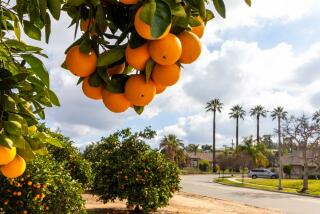Freeze Survivors: Kiwis, Kumquats
- Share via
California kiwi growers are lucky. Their fruit was picked in October, well ahead of the big chill. And the vines escaped damage because they go dormant in cold weather.
Despite spring winds, summer hot spells and continued drought, the 1990 crop amounted to a substantial 9.5 million trays (one tray holds about 36 kiwi), says Mark Houston, president of the Sacramento-based California Kiwifruit Commission.
Kiwi is grown in California from San Diego County north to Chico, with major concentrations of plantings in the central San Joaquin Valley and the northern Sacramento Valley. Some 9,000 acres are planted to the fruit, and the wholesale value of the annual crop is about $100 million, Houston says.
That means a lot of kiwi for American consumption, because overseas markets are dwindling. The European market is dominated by subsidized production from Italy and France. New Zealand, strengthened by a 60% increase in kiwi production last year, provides fruit for the Asian side of the Pacific Rim.
Competition with New Zealand for the American market is lessened by complementary harvests. California fruit, picked in October, goes into cold storage and is distributed from the first week of November to the first week of June. New Zealand imports take over from June to November, with some fruit lingering past that time.
Although other countries have higher per-capita consumption, the United States is the fastest-growing market for kiwi. “We’re in 94% of the markets in the United States,” Houston says, “and every market in Los Angeles.” Nationwide, the average retail price is 33 cents per fruit; in Los Angeles it’s 25 cents. And supermarket specials offer even lower prices.
Once a rare and trendy garnish, kiwi has gone so mainstream that it is being promoted as a nutritional powerhouse. The meat of two average-sized peeled fruits (140 grams) contains 230% of the U.S. recommended dietary allowance of Vitamin C, 450 milligrams of potassium, 3.7 grams of dietary fiber and no sodium. Kiwi is usually eaten peeled, but the skin is edible, too. Houston says, “You get a little extra fiber if you eat the peel.”
Another freeze survivor is the kumquat, which is now coming to market from Indio and San Diego County. This thin-skinned citrus has a mouth-puckering tang that gives way to a sweet aftertaste. It’s no replacement for oranges, but it does have a bright, fresh flavor. Kumquats are a specialty item. That means prices are never really low, but they should remain comparable to the levels of recent years. Handy to snack on because they’re bite-size and don’t require peeling, kumquats also make wonderful chutney and preserves. There’s plenty of time to experiment with them because they’ll be around until May.
More to Read
Eat your way across L.A.
Get our weekly Tasting Notes newsletter for reviews, news and more.
You may occasionally receive promotional content from the Los Angeles Times.










